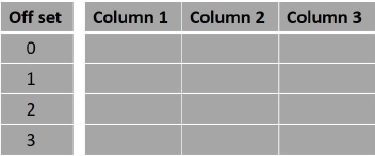
- Impala Tutorial
- Impala - Home
- Impala - Overview
- Impala - Environment
- Impala - Architecture
- Impala - Shell
- Impala - Query Language Basics
- Database Specific Statements
- Impala - Create a Database
- Impala - Drop a Database
- Impala - Select a Database
- Table Specific Statements
- Impala - Create Table Statement
- Impala - Insert Statement
- Impala - Select Statement
- Impala - Describe Statement
- Impala - Alter Table
- Impala - Drop a Table
- Impala - Truncate a Table
- Impala - Show Tables
- Impala - Create View
- Impala - Alter View
- Impala - Drop a View
- Impala - Clauses
- Impala - Order By Clause
- Impala - Group By Clause
- Impala - Having Clause
- Impala - Limit Clause
- Impala - Offset Clause
- Impala - Union Clause
- Impala - With Clause
- Impala - Distinct Operator
- Impala Useful Resources
- Impala - Quick Guide
- Impala - Useful Resources
- Impala - Discussion
Impala - Offset Clause
In general, the rows in the resultset of a select query starts from 0. Using the offset clause, we can decide from where the output should be considered. For example, if we choose the offset as 0, the result will be as usual and if we choose the offset as 5, the result starts from the fifth row.

Syntax
Following is the syntax of the offsetclause in Impala.
select data from table_name Group BY col_name;
Example
Assume we have a table named customers in the database my_db and its contents are as follows −
[quickstart.cloudera:21000] > select * from customers; Query: select * from customers +----+----------+-----+-----------+--------+ | id | name | age | address | salary | +----+----------+-----+-----------+--------+ | 3 | kaushik | 23 | Kota | 30000 | | 6 | Komal | 22 | MP | 32000 | | 1 | Ramesh | 32 | Ahmedabad | 20000 | | 5 | Hardik | 27 | Bhopal | 40000 | | 2 | Khilan | 25 | Delhi | 15000 | | 8 | ram | 22 | vizag | 31000 | | 9 | robert | 23 | banglore | 28000 | | 7 | ram | 25 | chennai | 23000 | | 4 | Chaitali | 25 | Mumbai | 35000 | +----+----------+-----+-----------+--------+ Fetched 9 row(s) in 0.51s
You can arrange the records in the table in the ascending order of their id’s and limit the number of records to 4, using limit and order by clauses as shown below.
Query: select * from customers order by id limit 4 +----+----------+-----+-----------+--------+ | id | name | age | address | salary | +----+----------+-----+-----------+--------+ | 1 | Ramesh | 32 | Ahmedabad | 20000 | | 2 | Khilan | 25 | Delhi | 15000 | | 3 | kaushik | 23 | Kota | 30000 | | 4 | Chaitali | 25 | Mumbai | 35000 | +----+----------+-----+-----------+--------+ Fetched 4 row(s) in 0.64s
Following is an example of the offset clause. Here, we are getting the records in the customers table in the order of their id’s and printing the first four rows starting from the 0th row.
[quickstart.cloudera:21000] > select * from customers order by id limit 4 offset 0;
On executing, the above query gives the following result.
Query: select * from customers order by id limit 4 offset 0 +----+----------+-----+-----------+--------+ | id | name | age | address | salary | +----+----------+-----+-----------+--------+ | 1 | Ramesh | 32 | Ahmedabad | 20000 | | 2 | Khilan | 25 | Delhi | 15000 | | 3 | kaushik | 23 | Kota | 30000 | | 4 | Chaitali | 25 | Mumbai | 35000 | +----+----------+-----+-----------+--------+ Fetched 4 row(s) in 0.62s
In the same way, you can get four records from the customers table starting from the row having offset 5 as shown below.
[quickstart.cloudera:21000] > select * from customers order by id limit 4 offset 5; Query: select * from customers order by id limit 4 offset 5 +----+--------+-----+----------+--------+ | id | name | age | address | salary | +----+--------+-----+----------+--------+ | 6 | Komal | 22 | MP | 32000 | | 7 | ram | 25 | chennai | 23000 | | 8 | ram | 22 | vizag | 31000 | | 9 | robert | 23 | banglore | 28000 | +----+--------+-----+----------+--------+ Fetched 4 row(s) in 0.52s